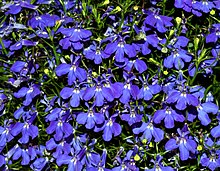Lobelia
| Lobelia | |
|---|---|

| |
| Lobelia erinus | |
| Scientific classification | |
| Kingdom: | Plantae |
| Clade: | Tracheophytes |
| Clade: | Angiosperms |
| Clade: | Eudicots |
| Clade: | Asterids |
| Order: | Asterales |
| Family: | Campanulaceae |
| Subfamily: | Lobelioideae |
| Genus: | Lobelia L.[1] |
| Type species | |
| Lobelia cardinalis | |
| Species | |
| Synonyms[3] | |
|
List
| |

Lobelia (/loʊˈbiːliə, lə-/[4][5][6]) is a genus of flowering plants in the family Campanulaceae comprising 415 species,[7] with a subcosmopolitan distribution primarily in tropical to warm temperate regions of the world, a few species extending into cooler temperate regions.[8] They are known generally as lobelias.[9]

Description
The genus Lobelia comprises a substantial number of large and small annual, perennial and shrubby species, hardy and tender, from a variety of habitats, in a range of colours. Many species appear totally dissimilar from each other. However, all have simple, alternate leaves and two-lipped tubular flowers, each with five lobes. The upper two lobes may be erect while the lower three lobes may be fanned out. Flowering is often abundant and the flower colour intense, hence their popularity as ornamental garden subjects.[10]
Taxonomy
The genus Lobelia was first formally described in 1753 by
Lobelia is probably the base form from which many other
A New Zealand study concluded that local species of Hypsela, Isotoma and Pratia should be treated as Lobelia.[15]
Species list
Ecology
Lobelia species are used as food plants by the
Cultivation and uses
Several species are cultivated as ornamental plants in gardens. These include Lobelia cardinalis syn. Lobelia fulgens (cardinal flower or Indian pink), Lobelia siphilitica (blue lobelia), and Lobelia erinus, which is used for edging and window boxes.[10]
Hybrids
Numerous hybrids have been produced, notably Lobelia × speciosa, a hybrid derived from L. fulgens, L. cardinalis & L. siphilitica. The term "fan hybrids" is also used.[16] This plant is borderline hardy and requires fertile, moist soil. It is suitable for summer bedding schemes or growing in containers. The cultivars 'Kompliment Scharlach'[17] and 'Pink Elephant'[18] have gained the Royal Horticultural Society's Award of Garden Merit.[19]
Traditional medicine
The species used most commonly in modern herbalism is
Lobelia has been used as "asthmador" in Appalachian traditional medicine.[22] Two species, L. siphilitica and L. cardinalis, were once considered a cure for syphilis.[23] Herbalist Samuel Thomson popularized medicinal use of lobelia in the United States in the early 19th century.[20]
Adverse effects
Many members of the genus are considered poisonous, with some containing the toxic principle lobeline.[24] Because of lobeline's similarity to nicotine, the internal use of lobelia may be dangerous to susceptible populations, including children, pregnant women,[25] and individuals with cardiac disease. Excessive use will cause nausea and vomiting.[26] It is not recommended for use by pregnant women and is best administered by a practitioner qualified in its use. It also has a chemical known as lobellicyonycin,[citation needed] which may cause dizziness.
Chemical constituents


Extracts of Lobelia inflata contain lobeline[28] and those from Lobelia chinensis contain apigenin, lobeline, lobelanine, isolobelanine, lobelanidine, quercetin, coumarins, glucosides and other flavonoids.[29]


Mexican spurred lobelias
About eleven species native to Mexico and Central America have spurs on the flowers. These spurred lobelias appear to form a monophyletic group. Most have been classified in the genera Heterotoma (or sometimes Calcaratolobelia). However, since their closest relatives such as Lobelia anatina are in Lobelia, Koopman and Ayers classify them in Lobelia.[30]
References
- ^ "Genus: Lobelia L." Germplasm Resources Information Network. United States Department of Agriculture. 1999-01-27. Archived from the original on 2010-05-29. Retrieved 2011-02-03.
- ^ lectotype designated by Hitchcock & Green, Nomenclature, Proposals by British Botanists 184 (1929)
- ^ Kew World Checklist of Selected Plant Families
- ^ "Lobelia". Lexico UK English Dictionary. Oxford University Press. Archived from the original on 2019-12-20.
- ^ "Lobelia". Merriam-Webster.com Dictionary. Retrieved 2016-01-21.
- ^ Sunset Western Garden Book, 1995:606–607
- S2CID 84676862.
- ISBN 0-333-47494-5.
- ^ Lobelia. USDA PLANTS.
- ^ ISBN 978-1405332965.
- ^ "Lobelia". APNI. Retrieved 11 January 2021.
- ^ Linnaeus, Carl (1753). Species Plantarum. p. 929. Retrieved 11 January 2021.
- ISBN 9781910455067, p. 89
- PMID 11454630.
- S2CID 84665178.
- ^ Paghat's Garden: "Fan Burgundy" Cardinal Flower
- ^ "RHS Plant Selector - Lobelia × speciosa 'Kompliment Scharlach'". Retrieved 2 October 2020.
- ^ "RHS Plant Selector - Lobelia × speciosa 'Pink Elephant'". Retrieved 2 October 2020.
- ^ "AGM Plants - Ornamental" (PDF). Royal Horticultural Society. March 2020. p. 66. Retrieved 25 October 2020.
- ^ a b "Lobelia". EBSCO Complementary and Alternative Medicine (CAM) Review Board. January 2006. Retrieved 2007-09-12.
- PMID 20633025.
- ISBN 0-87488-182-X
- ^ Guédon, Marie-Françoise (2000). Sacred Smudging in North America. Walkabout Press.
- ^ Bergner P. (1998). "Lobelia toxicity: A literature review". Medical Herbalism. 10 (1–2): 15–34.
- Memorial Sloan-Kettering Cancer Center
- ^ Lobelia, drugs.com
- PMID 21778282.
- PMID 18222670.
- S2CID 26186424.
- PMID 21652434.
Bibliography
- Everitt, J.H.; Lonard, R.L.; Little, C.R. (2007). Weeds in South Texas and Northern Mexico. Lubbock: Texas Tech University Press. ISBN 978-0-89672-614-7.
- Thomson, Samuel (1884) [1822]. "Life and Medical Discoveries of Samuel Thomson". Bulletin of the Lloyd Library of Botany, Pharmacy and Materia Medica. III (11).
External links
 Data related to Lobelia at Wikispecies
Data related to Lobelia at Wikispecies- Dressler, S.; Schmidt, M. & Zizka, G. (2014). "Lobelia". African plants – a Photo Guide. Frankfurt/Main: Forschungsinstitut Senckenberg.
